| Author |
Message |
|
Niels Just Rasmussen
|
 Posted: Fri 18 Dec, 2015 9:43 am Post subject: Posted: Fri 18 Dec, 2015 9:43 am Post subject: |
 |
|
| Kyle Eaton wrote: | | How common should I suspect pretzel-shaped crossguards were used by the Medieval Norse around the 15th century? I'm creating a few 15th century Swedish units for a total war mod (video game version of a table top miniatures war game), and I would like to attempt to make the units as historically correct as possible. What are the advantages to having a pretzel-shaped crossguard? |
It seems that they were used by both monarchies 1) Denmark/Norway/Slesvig-Holsten and 2) Sweden/Finland as we have located museum examples from their territories.
Certain soldiers would carry them to battle, but I think it highly unlikely you had "pretzel-sword-sections" of the army. Rather likely mixed in between pike- and pole-armed men. Mixed weaponry is better to cope with various challenges.
The pretzel as a guard covers more of the hand that a simple cross-guard - though some pretzels covers only the three sides of the blade and nothing or little of the fourth. Could be a temporal development towards more and more all-inclusive pretzels?
Wonder if techniques are comparable to messer's??
With a messers cross-guard and nagel you also have three sides of the blade having hand protection.
So is the fighting style perhaps a development of from 2-handed kriegs-messer techniques??
|
|
  |
 |
|
Niels Just Rasmussen
|
 Posted: Fri 18 Dec, 2015 2:00 pm Post subject: Posted: Fri 18 Dec, 2015 2:00 pm Post subject: |
 |
|
So a likely C-guard (halv-kringel) sword ready for an execution scene from a late gothic (1475-1550) church-wall-painting from Faxe Kirke on Zealand (Sjælland), though one of the quillons is somewhat obscured by his purse.
Dating: 1490-1510.
 Attachment: 112.94 KB Attachment: 112.94 KB
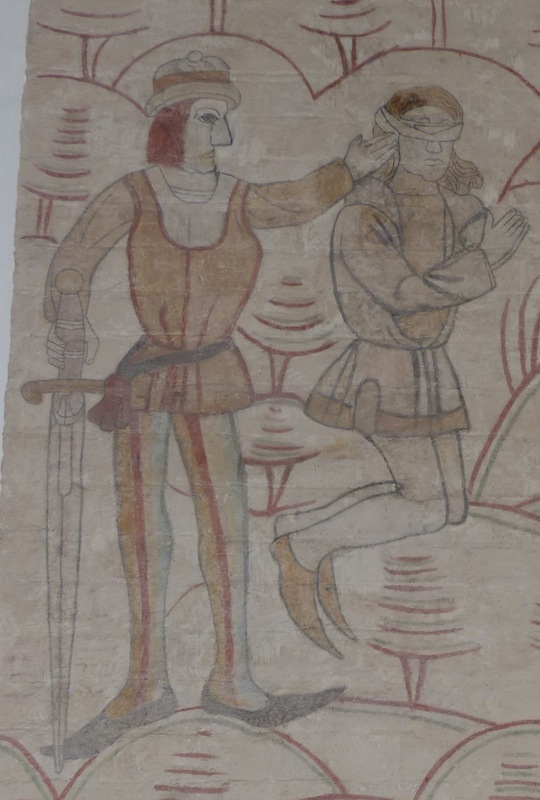
Scene from the legend of Skt. Jørgen (Saint George).
Source: http://natmus.dk/salg-og-ydelser/museumsfaglige-ydelser/kirker-og-kirkegaarde/kalkmalerier-i-danske-kirker/
Last edited by Niels Just Rasmussen on Mon 28 Dec, 2015 5:03 am; edited 1 time in total
|
|
  |
 |
|
Niels Just Rasmussen
|
 Posted: Sat 19 Dec, 2015 5:12 am Post subject: Posted: Sat 19 Dec, 2015 5:12 am Post subject: |
 |
|
Also found this rather splendid wall-painting from Dronninglund Kirke in Northern Jutland.
It is the only church in Europe that has paintings of all the "9 heroes": Dating: 1510-1525.
The three pagan heroes: Hektor of Troy, Alexander the Great and Caesar.
The three jewish heroes: Josva, Judas Makkabæus and David.
The three christian heroes: King Arthur, Charlemagne and Godfred (Godefroy) of Boullion.
So here is a scene (see attachement) with Hektor and David on horseback both wielding C-guard looking swords equipped with (metal?) rainguards.
It has to be said though that the swords could be Boringholm style swords as well, if the painter didn't get the perspective quite right causing the optical effect of curved cross-guards.
But Hektor's sword looks the most convincing with C-guard (halv-kringel).
 Attachment: 187.78 KB Attachment: 187.78 KB
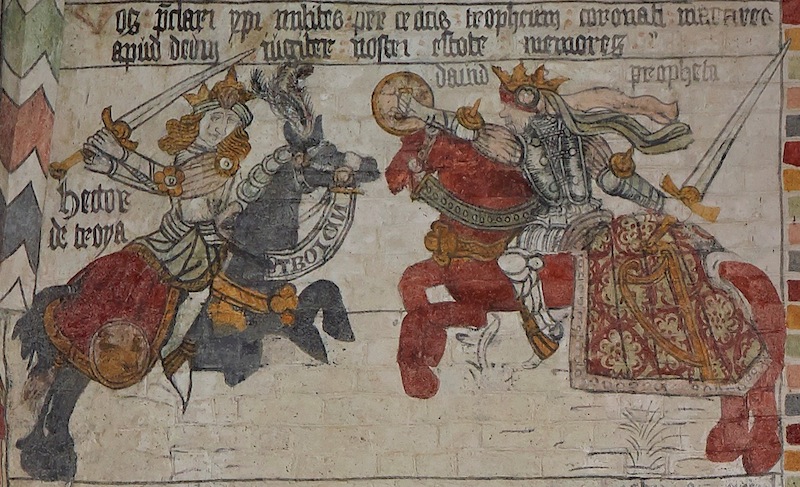
Dronninglund Kirke.
Hektor and David (harp on horse-blanket).
NB: "Boxed text" above the figures belongs to the image above.
Source: http://aalborgstift.dk/kirker/bronderslev/dronninglund-kirke/kalkmalerier/#_
Last edited by Niels Just Rasmussen on Mon 28 Dec, 2015 5:05 am; edited 1 time in total
|
|
  |
 |
|
Mark Lewis
|
 Posted: Sun 20 Dec, 2015 5:17 am Post subject: Posted: Sun 20 Dec, 2015 5:17 am Post subject: |
 |
|
| Niels Just Rasmussen wrote: | | So a likely C-guard (halv-kringel) sword ready for an execution scene from a late gothic (1475-1550) church-wall-painting from Faxe Kirke on Zealand (Sjælland), though one of the quillons is somewhat obscured by his purse. |
Interesting depiction! It seems like it could share other details with the D4446 sword from Hinge Sø, like the banded grip and round pommel. The fuller seems to have been carefully illustrated, and reminds of the the fullers on some of the XVIIIe's (though without the narrowed ricasso this time).
http://myArmoury.com/talk/viewtopic.php?p=305346#305346
There is one more type of curved cross which I have seen on just one example from Norway... instead of a C-guard, we have an S-guard!
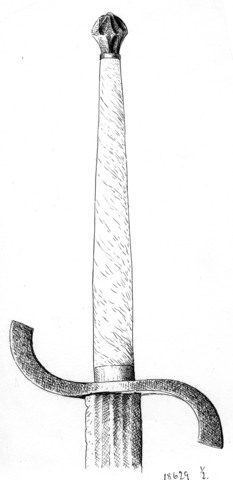
http://www.unimus.no/arkeologi/#/detailsView?search=C18629
it is quite similar to other swords we have already discussed In all respects apart from the guard: the pommel is the common, small, type T; the grip is very similar to D 787 above, with the smooth wood surface and metal capped end; the blade is large and multi-fullered (type XX?) like several of the kringel and halv-kringel blades, D4445 from Hinge Sø seems particularly similar.
| Niels Just Rasmussen wrote: | | Also found this rather splendid wall-painting from Dronninglund Kirke in Northern Jutland. |
Do you know the date for this one?
|
|
   |
 |
|
Niels Just Rasmussen
|
 Posted: Sun 20 Dec, 2015 9:51 am Post subject: Posted: Sun 20 Dec, 2015 9:51 am Post subject: |
 |
|
Mark - you are right the C-guard sword on the Faxe Church painting really is very close looking in regard to the style with metal bands, capping pommel and thick (round?) wooden grip on the Hinge Sø sword (D 4446) AND also to the pretzel sword in middle of Koppeschar's picture (787) AND the Finnish pretzel sword earlier in this thread AND maybe also the "ricassoed" D 16140 - (only ricasso XVIIIe with straight cross-guard).
About the norwegian S-guard sword. Totally agree that beside Hinge Sø (D 4445) the multi-fullered-blade also looks like many of the pretzel swords (for instance Tude Å, the Norwegian C13815 and the Swedish Swedish Army Museum, AM.060638).
The type of S-curvature on the Norwegian sword also looks a lot like the s-curvature on the Tingsted Church painting, though these blades seem shorter [the curvature of the S follows the plane of the blade edges on the Scandinavian ones, whereas the Dührer and the Higgins armoury example the S-curvature turns away from the plane of the blade-edges !!].
I would also agree they look like Oakeshott Type XX blades with regard to the fullers, but I have a suspicion that the blade geometry differs. The Scandinavian swords looks "convex", don't they? [meaning thickest at the blade center].
Dronninglund Kirke's paintings are also regarded as "Late gothic" in style so 1475-1550. -> precise dating is 1510-1525.
Last edited by Niels Just Rasmussen on Tue 29 Dec, 2015 4:46 am; edited 1 time in total
|
|
  |
 |
|
Niels Just Rasmussen
|
 Posted: Wed 23 Dec, 2015 5:39 am Post subject: Posted: Wed 23 Dec, 2015 5:39 am Post subject: |
 |
|

The e) sword in the Plate from E.A. Christensen's collection also appears in "Gammelt Jern" (1968), so I can give the stats of the sword:
Find-spot: Outer moat of the castle Dragsholm in Denmark.
Bought in 1933 by E.A. Christensen (with 3 other swords) when the castle was sold.
Pommel: Ball-shaped.
Grip: 36 cm.
Cross-guard: Traces of "snoreknytning" (apparently what Bruhn-Hoffmeyer calls the "pretzel"-guard).
Blade length: 97 cm. (rhombic blade geometry).
Blade width: 5,8 cm.
Blade has traces of brass inlayed figures, otherwise very rusty.
-> So sword is 36+97 cm = 133 cm + a couple of pommel cm's.
Last edited by Niels Just Rasmussen on Sat 26 Dec, 2015 3:15 am; edited 2 times in total
|
|
  |
 |
|
Mark Lewis
|
 Posted: Thu 24 Dec, 2015 6:56 am Post subject: Posted: Thu 24 Dec, 2015 6:56 am Post subject: |
 |
|
| Niels Just Rasmussen wrote: | | I would also agree they look like Oakeshott Type XX blades with regard to the fullers, but I have a suspicion that the blade geometry differs. The Scandinavian swords looks "convex", don't they? [meaning thickest at the blade center]. |
I can see what you mean, they give the impression of being relatively thick, heavy blades (though photos can always be deceptive). Reviewing Records, Oakeshott's XX.3 and XX.4 seem to be very similar in the arrangement of fullers and overall blade profile and proportions, so I don't think it stretches the typology too far to include many of these Scandinavian pretzel-hilts in the category.
| Niels Just Rasmussen wrote: | | The e) sword in the Plate from E.A. Christensen's collection has actually a fully preserved blade (just the image of Bruhn-Hoffmeyer's book that cuts of the rest of the sword). As I know have received "Gammelt Jern" (1968) I can give the stats of the sword: |
Is this plate from Gammelt Jern? It is the only one I have come across online... (e) appears to be on the left, and a bit longer as you say:

If this is the correct photo, the dimensions as shown don't seem to match the description... in particular the blade appears much shorter (could be just foreshortening in the photo, hard to avoid with very long blades).
|
|
   |
 |
Luka Borscak

|
 Posted: Thu 24 Dec, 2015 12:45 pm Post subject: Posted: Thu 24 Dec, 2015 12:45 pm Post subject: |
 |
|
These are thick, massive swords. Everything about them is massive. I was very impressed with them recently when I was in National museum in Copenhagen.
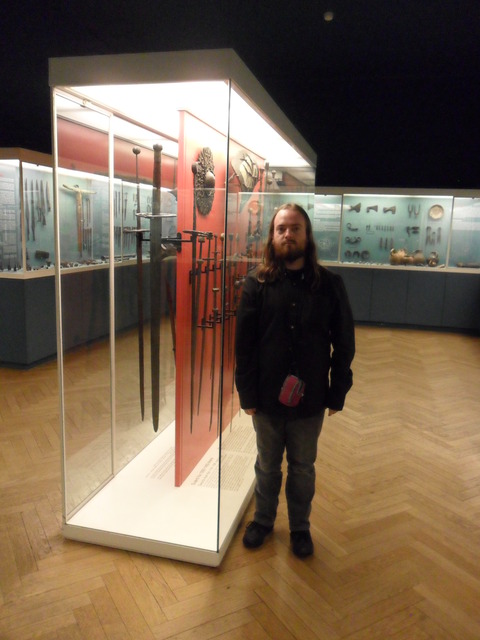
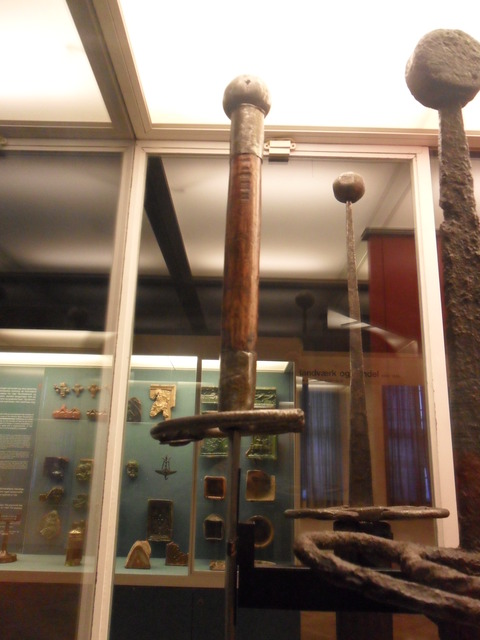
I have much more pictures, I will post them later.
|
|
  |
 |
Luka Borscak

|
 Posted: Thu 24 Dec, 2015 1:22 pm Post subject: Posted: Thu 24 Dec, 2015 1:22 pm Post subject: |
 |
|
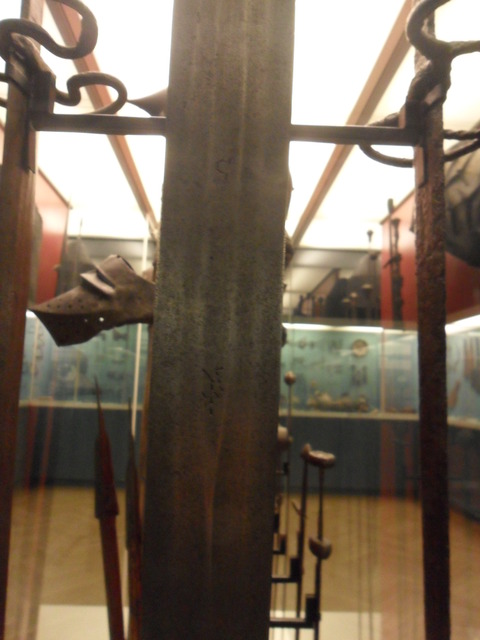
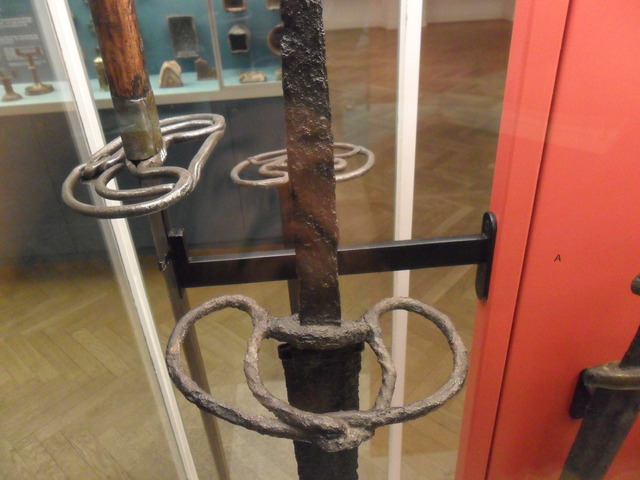
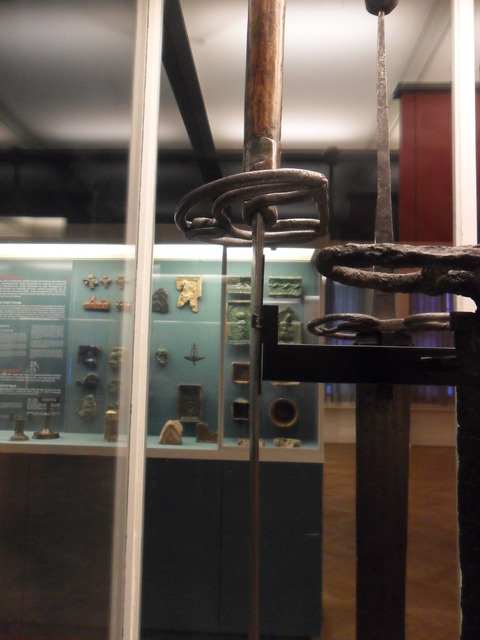
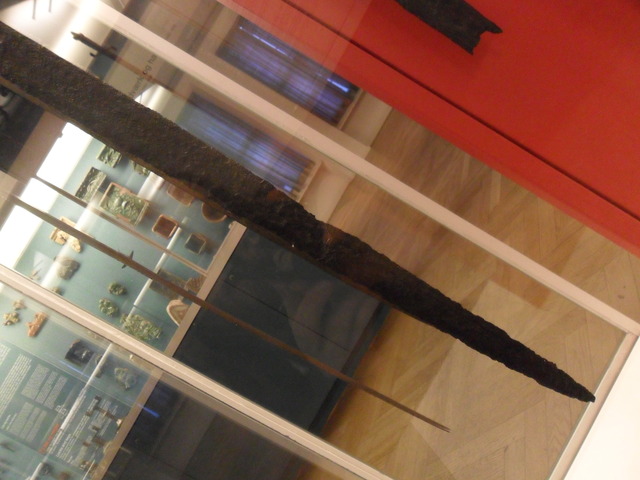
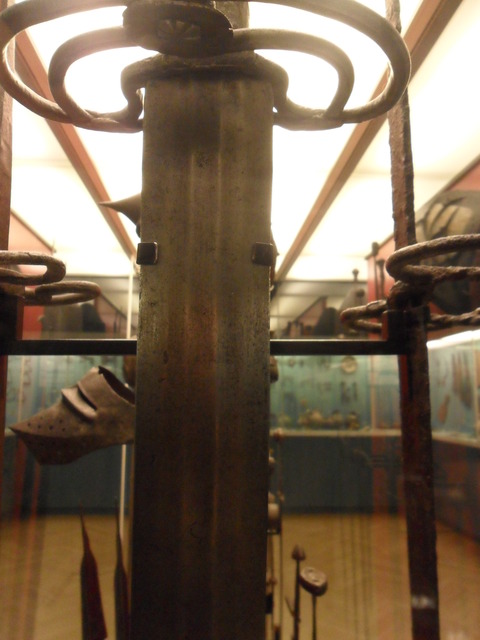
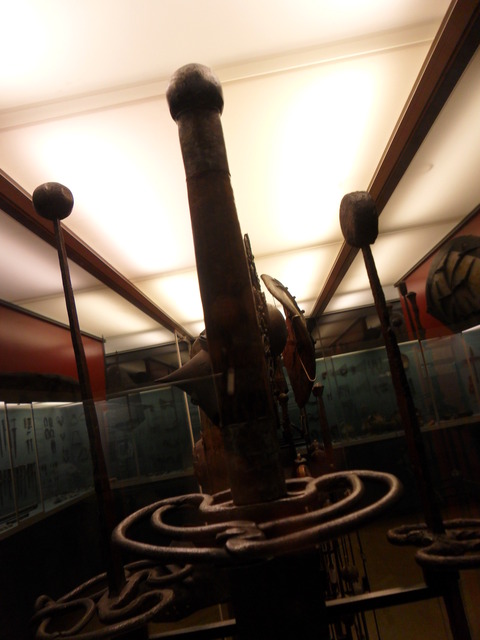
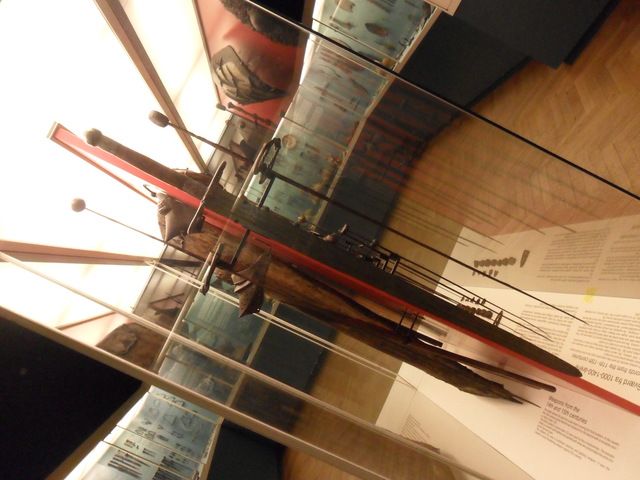

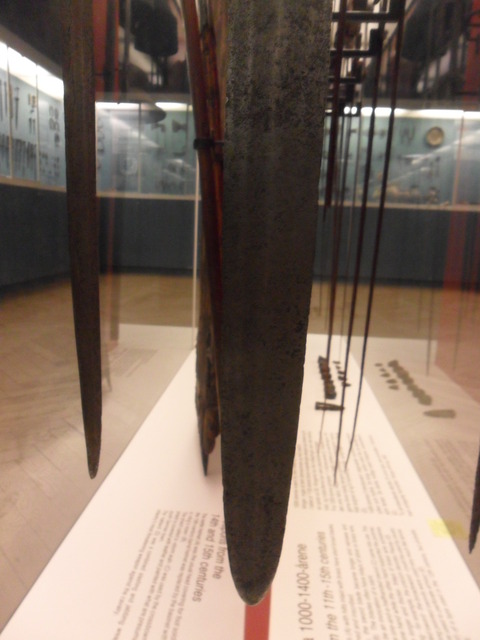
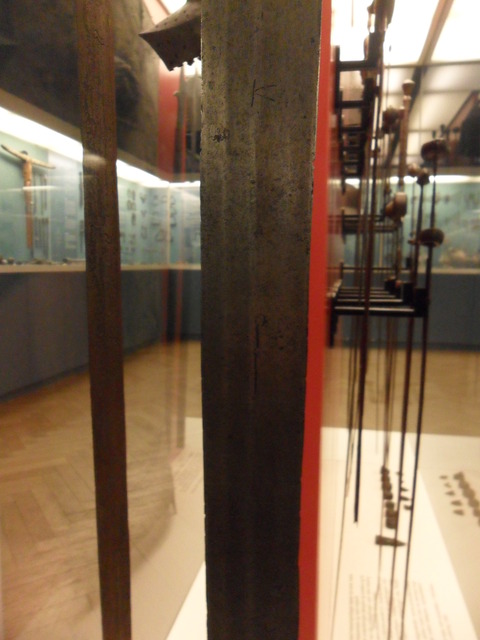
|
|
  |
 |
Luka Borscak

|
 Posted: Thu 24 Dec, 2015 1:26 pm Post subject: Posted: Thu 24 Dec, 2015 1:26 pm Post subject: |
 |
|
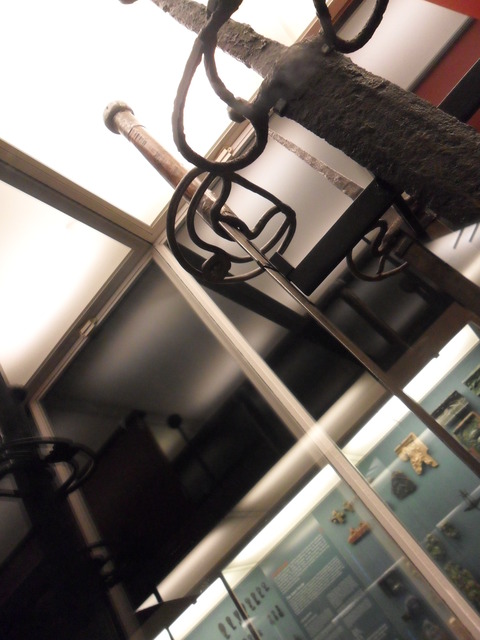
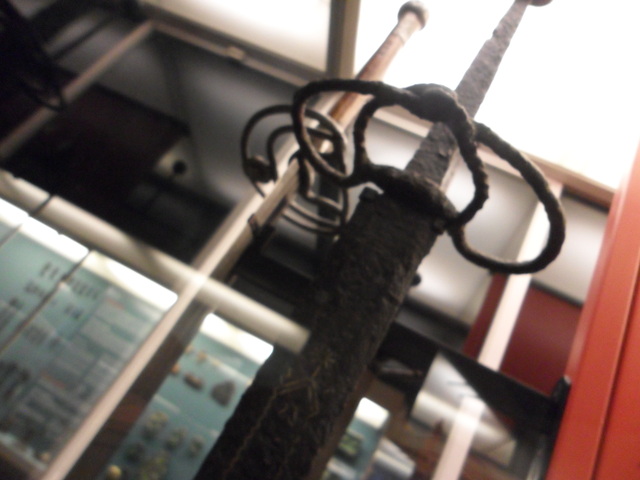
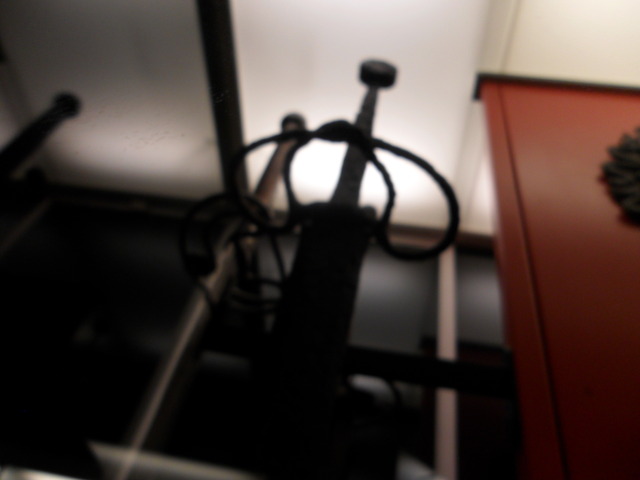


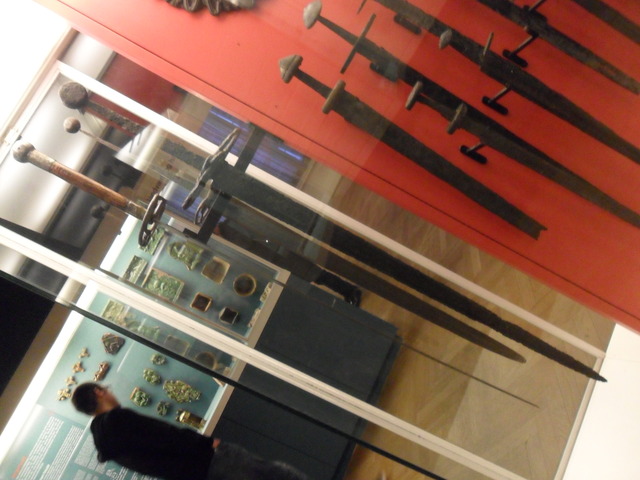
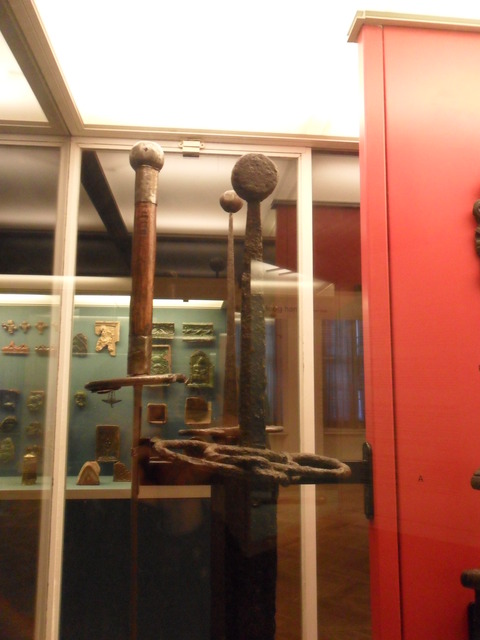

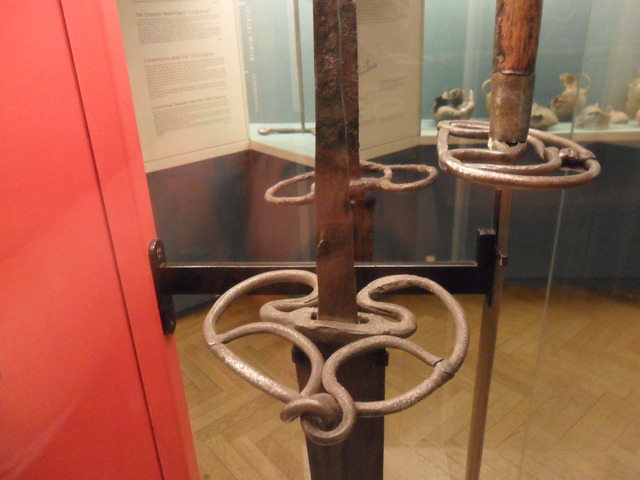
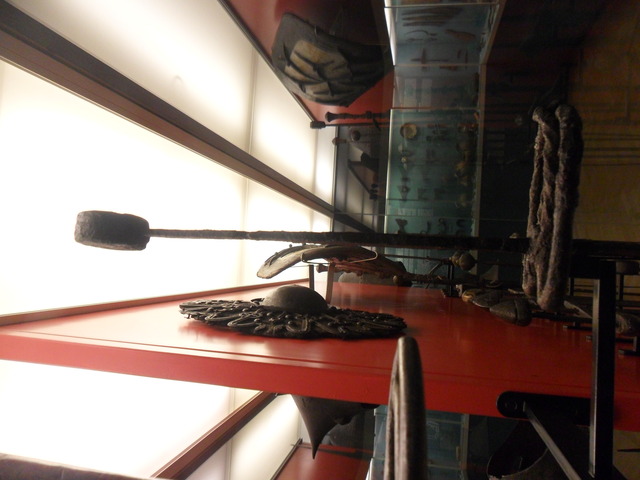
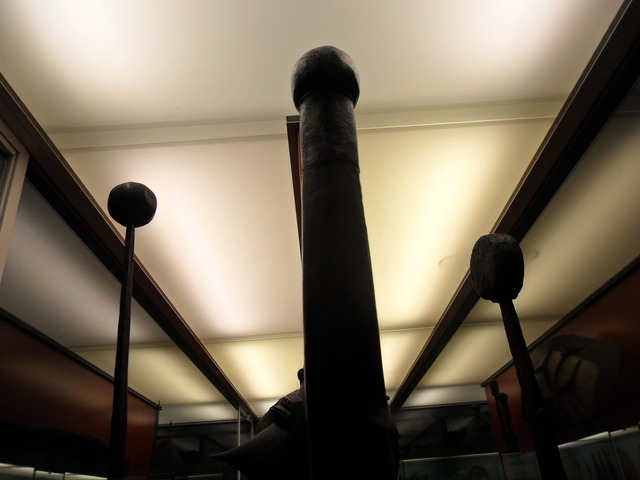
|
|
  |
 |
|
Mark Lewis
|
 Posted: Fri 25 Dec, 2015 2:50 pm Post subject: Posted: Fri 25 Dec, 2015 2:50 pm Post subject: |
 |
|
| Luka Borscak wrote: | These are thick, massive swords. Everything about them is massive. I was very impressed with them recently when I was in National museum in Copenhagen.
I have much more pictures, I will post them later. |
Thanks for sharing these, Luka. 
|
|
   |
 |
|
Niels Just Rasmussen
|
 Posted: Sat 26 Dec, 2015 3:07 am Post subject: Posted: Sat 26 Dec, 2015 3:07 am Post subject: |
 |
|
| Mark Lewis wrote: | | Niels Just Rasmussen wrote: | | I would also agree they look like Oakeshott Type XX blades with regard to the fullers, but I have a suspicion that the blade geometry differs. The Scandinavian swords looks "convex", don't they? [meaning thickest at the blade center]. |
I can see what you mean, they give the impression of being relatively thick, heavy blades (though photos can always be deceptive). Reviewing Records, Oakeshott's XX.3 and XX.4 seem to be very similar in the arrangement of fullers and overall blade profile and proportions, so I don't think it stretches the typology too far to include many of these Scandinavian pretzel-hilts in the category.
| Niels Just Rasmussen wrote: | | The e) sword in the Plate from E.A. Christensen's collection has actually a fully preserved blade (just the image of Bruhn-Hoffmeyer's book that cuts of the rest of the sword). As I know have received "Gammelt Jern" (1968) I can give the stats of the sword: |
Is this plate from Gammelt Jern? It is the only one I have come across online... (e) appears to be on the left, and a bit longer as you say:

If this is the correct photo, the dimensions as shown don't seem to match the description... in particular the blade appears much shorter (could be just foreshortening in the photo, hard to avoid with very long blades). |
I have figured out that actually two articles on E.A. Christensen's weapon collection have been published in the "Vaabenhistorisk Aarbog".
Your picture is probably from the first article by Smith & Jacobsen (1935) Vaabenhistoriske Aarbøger Ib.
I was able to locate Bruhn-Hoffmeyer (1968) from Vaabenhistoriske Aarbøger XIV.
So actually I missed that E.A. Christensen had 2 pretzel swords. The one that appears on Bruhn-Hoffmeyers doctoral work and the one from the first publication on his collection, which is likely the picture you had. This pretzel sword is semi-preserved. [I have now given the correct stats for that sword in the former post in this thread about it.]
Between 1954-1968 he had acquired a much better preserved pretzel sword! (see attachment).
This is the one where the blade to end in a sharp point.
So the stats for this well preserved pretzel sword are the following:
Presumed Danish two-handed sword. Find-spot unknown.
Pommel: Ball-shaped ~4 cm in diameter.
Grip: ~28 cm.
Cross-guard: Strongly bent & compressed with ends "udsmedet til 2 firkantede tappe" [how to translate this ? -> ends hammered into two square pivots?].
Blade length: ~102 cm
Blade width: ~5 cm [almost parallel edges the first 2/3 of the blade, then shallowing ended up in a sharp point]
Both sides of the blade have brass inlayed marks: Wolf figure and stars [probably Passau].
-> So total length must be 4+28+102 = ~134 cm.
So likely the case of a German blade fitted in Denmark.
PS: Thanks Luka for your excellent pictures from Nationalmuseet! 
 Attachment: 94.3 KB Attachment: 94.3 KB
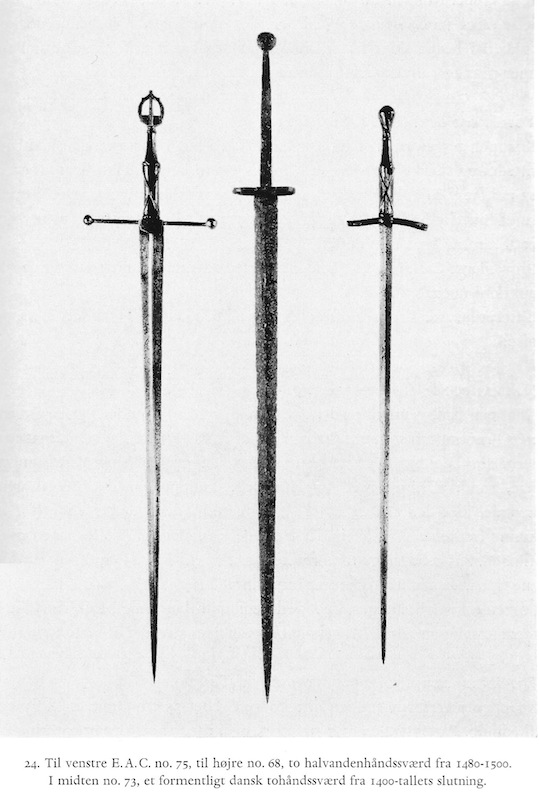
Pretzel sword (center).
E.A. Christensen collection.
Source: Ada Bruhn-Hoffmeyer (1968)
Vaabenhistoriske Aarbøger XIV
Last edited by Niels Just Rasmussen on Tue 29 Dec, 2015 5:57 am; edited 1 time in total
|
|
  |
 |
|
Niels Just Rasmussen
|
|
  |
 |
|
Niels Just Rasmussen
|
 Posted: Tue 29 Dec, 2015 6:21 am Post subject: Posted: Tue 29 Dec, 2015 6:21 am Post subject: |
 |
|
Another strange sword from a Danish church - Ejsing Kirke in Jutland.
In a painting of Paulus and a painting of Skt. Katharina (both dated 1500-1510) they both holds what looks to be C-guard swords with rainguard. So it looks like the swords in Dronninglund Kirke (dated 1510-1525), but these have a colossal ball-shaped pommel - ball-shaped pommels we find on many pretzel swords!
The possible C-guard curvature looks most obvious on the Katharina depiction.
Probably the same sword (a local nobleman's?) in the hands of two saintly figures.
It certainly makes for the occurrence of C-guard swords in the early 1500's.
 Attachment: 63.32 KB Attachment: 63.32 KB

Paulus with sword.
Ejsing Kirke.
Source: http://natmus.dk/salg-og-ydelser/museumsfaglige-ydelser/kirker-og-kirkegaarde/kalkmalerier-i-danske-kirker/
 Attachment: 72.67 KB Attachment: 72.67 KB
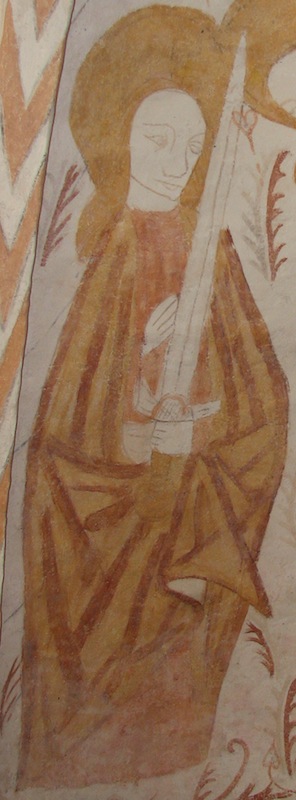
Skt. Katharina with sword.
Ejsing Kirke.
Source: http://natmus.dk/salg-og-ydelser/museumsfaglige-ydelser/kirker-og-kirkegaarde/kalkmalerier-i-danske-kirker/
|
|
  |
 |
|
Niels Just Rasmussen
|
 Posted: Sat 02 Jan, 2016 6:56 am Post subject: Posted: Sat 02 Jan, 2016 6:56 am Post subject: |
 |
|
| Mark Lewis wrote: | In the Swedish Army Museum, AM.060638:
 |
The link to this sword is here:
Source: http://digitaltmuseum.se/011024416377#!
Interesting hollowed out pommel by the way on this sword. Seems it would have had inlay.
55 cm is left of the sword blade and it is 5,5 cm wide at the base.
They inform that the original cross-guard in this late 1400's German sword was removed and replaced with the pretzel.
Unclear if this is just speculation or whether it can actually be seen on the blade? [as they could have got a bare blade from Germany and fitted it in Sweden].
|
|
  |
 |
|
Niels Just Rasmussen
|
 Posted: Wed 13 Jan, 2016 12:56 pm Post subject: Posted: Wed 13 Jan, 2016 12:56 pm Post subject: |
 |
|
Found a gravestone from Ringsted Kirke, showing the Knight (from 1529) and Scanian nobleman Mourits Olufsen Krognos til Krapperup, Bollerup & Bregentved, who died in 1550.
It's actually the largest gravestone in Denmark measuring 410*210 cm.
Mourits Olufsen Krognos holds a multi-fullered blade going almost all the way to the tip! Seems to be perhaps a bit like a Hinge type C-guard as well. Has also a decorated fabric "hand protection".

Source: http://www.gravstenogepitafier.dk/
Actual details from the stone:

Source: http://www.gravstenogepitafier.dk/
Probably a sword he had during the 1520-30's when more young and active?
Krognos Coat-of-Arms:

Source: https://da.wikipedia.org/wiki/Krognos
|
|
  |
 |
|
Mark Lewis
|
 Posted: Wed 13 Jan, 2016 7:13 pm Post subject: Posted: Wed 13 Jan, 2016 7:13 pm Post subject: |
 |
|
| Niels Just Rasmussen wrote: | Found a gravestone from Ringsted Kirke, showing the Knight (from 1529) and Scanian nobleman Mourits Olufsen Krognos til Krapperup, Bollerup & Bregentved, who died in 1550.
It's actually the largest gravestone in Denmark measuring 410*210 cm.
Mourits Olufsen Krognos holds a multi-fullered blade going almost all the way to the tip! |
Interesting! Now to my eye, this seems like it might be a good comparison for the Maihuigen and Malmo swords that we discussed earlier in the other thread, with the possible similarity in the fullers, similar cross, similar dimensions and proportions... no finger-guard though. I think it still supports the later dating of the Maihuigen sword in particular compared to the various other Scandinavian two-handers under discussion.


http://myArmoury.com/talk/viewtopic.php?p=305906#305906
|
|
   |
 |
|
Niels Just Rasmussen
|
 Posted: Thu 14 Jan, 2016 1:34 pm Post subject: Posted: Thu 14 Jan, 2016 1:34 pm Post subject: |
 |
|
| Mark Lewis wrote: | | Niels Just Rasmussen wrote: | Found a gravestone from Ringsted Kirke, showing the Knight (from 1529) and Scanian nobleman Mourits Olufsen Krognos til Krapperup, Bollerup & Bregentved, who died in 1550.
It's actually the largest gravestone in Denmark measuring 410*210 cm.
Mourits Olufsen Krognos holds a multi-fullered blade going almost all the way to the tip! |
Interesting! Now to my eye, this seems like it might be a good comparison for the Maihuigen and Malmo swords that we discussed earlier in the other thread, with the possible similarity in the fullers, similar cross, similar dimensions and proportions... no finger-guard though. I think it still supports the later dating of the Maihuigen sword in particular compared to the various other Scandinavian two-handers under discussion.
|
I don't disagree, but it could be a sword he used in his squire-knightly prime 1520-30's and not being current fashion for 1550 when he died. So we agree on late - but is it Post-reformation-1540's or even as late as 1580's, or somewhere in between?
The similarity with especially the Maihaugen sword from Norway is very good (blade type, quillons and perhaps pommel - just finger guard is missing). With the Malmø sword we both have a different blade type and no finder guard.
|
|
  |
 |
|
Niels Just Rasmussen
|
 Posted: Fri 22 Jan, 2016 7:29 am Post subject: Posted: Fri 22 Jan, 2016 7:29 am Post subject: |
 |
|
So far I have not been able to find a clear example of a Pretzel sword from a Danish church depiction, but this is the closest match I have found so far.
We have multi-fullered blade. [Shame that damage to the painting has removed the last part of the blade].
We have a ball pommel.
We have a thick two-handed grip.
and a very thick and short looking cross-guard, so I wonder if this is the artist's attempt of showing a pretzel sword.
The image also shows a small rain-guard.
So is this a pretzel sword? - it certainly fits in the other categories, where it looks very much like the "787" from Nationalmuseet.
Image of Matthæus with sword is from a church in Jutland - Udbyneder Kirke.
Dating is 1490-1510. So also fit with the time period.
Other guy is Bartolomæus.
 Attachment: 116.54 KB Attachment: 116.54 KB
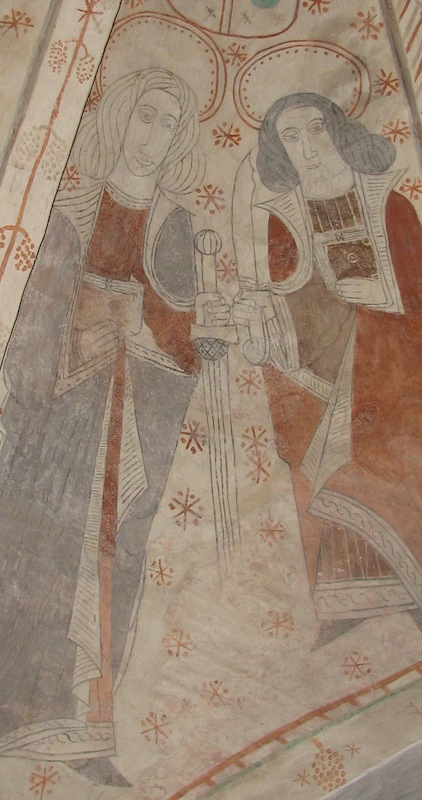
Matthæus with sword.
Udbyneder Kirke.
Dating: 1490-1510.
Source: http://natmus.dk/salg-og-ydelser/museumsfaglige-ydelser/kirker-og-kirkegaarde/kalkmalerier-i-danske-kirker/
|
|
  |
 |
|
Mark Lewis
|
 Posted: Sat 23 Jan, 2016 5:19 am Post subject: Posted: Sat 23 Jan, 2016 5:19 am Post subject: |
 |
|
| Niels Just Rasmussen wrote: | | So far I have not been able to find a clear example of a Pretzel sword from a Danish church depiction, but this is the closest match I have found so far. |
This is a great example, your searching has paid off! Is it the first depiction of the multiple fullers that you have found in the frescos?
The cross is a little puzzling... I know one of the museums holding a pretzel-hilt (forget which) claims that the pretzel-hilt was a later replacement to the original cross. I don't know what the basis of that claim was, but maybe this fresco is a clue in that direction also.
I was going to say that it was odd to see Matthew depicted with a sword (which is usually the attribute of St. Paul) but it is apparently a known variant in iconography.
http://www.christianiconography.info/matthew.html
|
|
   |
 |
|
|

